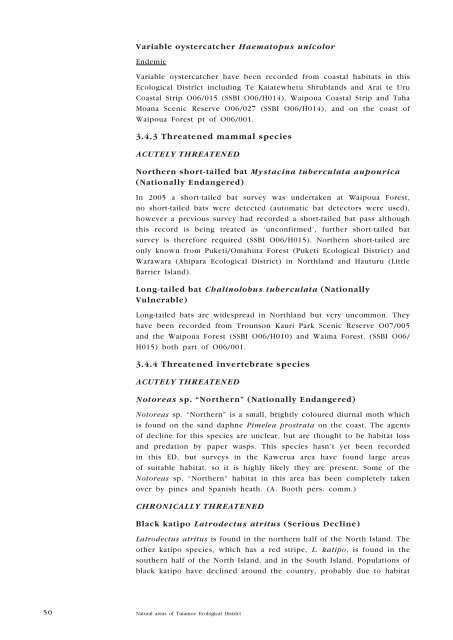Natural areas of Tutamoe Ecological District (3. Ecological character)
Natural areas of Tutamoe Ecological District (3. Ecological character)
Natural areas of Tutamoe Ecological District (3. Ecological character)
You also want an ePaper? Increase the reach of your titles
YUMPU automatically turns print PDFs into web optimized ePapers that Google loves.
Variable oystercatcher haematopus unicolor<br />
Endemic<br />
Variable oystercatcher have been recorded from coastal habitats in this<br />
<strong>Ecological</strong> <strong>District</strong> including Te Kaiatewhetu Shrublands and Arai te Uru<br />
Coastal Strip O06/015 (SSBI O06/H014), Waipoua Coastal Strip and Taha<br />
Moana Scenic Reserve O06/027 (SSBI O06/H014), and on the coast <strong>of</strong><br />
Waipoua Forest pt <strong>of</strong> O06/001.<br />
<strong>3.</strong>4.3 Threatened mammal species<br />
Acutely threAtened<br />
Northern short-tailed bat Mystacina tuberculata aupourica<br />
(Nationally Endangered)<br />
In 2005 a short-tailed bat survey was undertaken at Waipoua Forest,<br />
no short-tailed bats were detected (automatic bat detectors were used),<br />
however a previous survey had recorded a short-tailed bat pass although<br />
this record is being treated as ‘unconfirmed’, further short-tailed bat<br />
survey is therefore required (SSBI O06/H015). Northern short-tailed are<br />
only known from Puketi/Omahuta Forest (Puketi <strong>Ecological</strong> <strong>District</strong>) and<br />
Warawara (Ahipara <strong>Ecological</strong> <strong>District</strong>) in Northland and Hauturu (Little<br />
Barrier Island).<br />
Long-tailed bat chalinolobus tuberculata (Nationally<br />
Vulnerable)<br />
Long-tailed bats are widespread in Northland but very uncommon. They<br />
have been recorded from Trounson Kauri Park Scenic Reserve O07/005<br />
and the Waipoua Forest (SSBI O06/H010) and Waima Forest, (SSBI O06/<br />
H015) both part <strong>of</strong> O06/001.<br />
<strong>3.</strong>4.4 Threatened invertebrate species<br />
Acutely threAtened<br />
notoreas sp. “Northern” (Nationally Endangered)<br />
Notoreas sp. “Northern” is a small, brightly coloured diurnal moth which<br />
is found on the sand daphne Pimelea prostrata on the coast. The agents<br />
<strong>of</strong> decline for this species are unclear, but are thought to be habitat loss<br />
and predation by paper wasps. This species hasn’t yet been recorded<br />
in this ED, but surveys in the Kawerua area have found large <strong>areas</strong><br />
<strong>of</strong> suitable habitat, so it is highly likely they are present. Some <strong>of</strong> the<br />
Notoreas sp. “Northern” habitat in this area has been completely taken<br />
over by pines and Spanish heath. (A. Booth pers. comm.)<br />
chrOnIcAlly threAtened<br />
Black katipo latrodectus atritus (Serious Decline)<br />
Latrodectus atritus is found in the northern half <strong>of</strong> the North Island. The<br />
other katipo species, which has a red stripe, L. katipo, is found in the<br />
southern half <strong>of</strong> the North Island, and in the South Island. Populations <strong>of</strong><br />
black katipo have declined around the country, probably due to habitat<br />
50 <strong>Natural</strong> <strong>areas</strong> <strong>of</strong> <strong>Tutamoe</strong> <strong>Ecological</strong> <strong>District</strong>

















